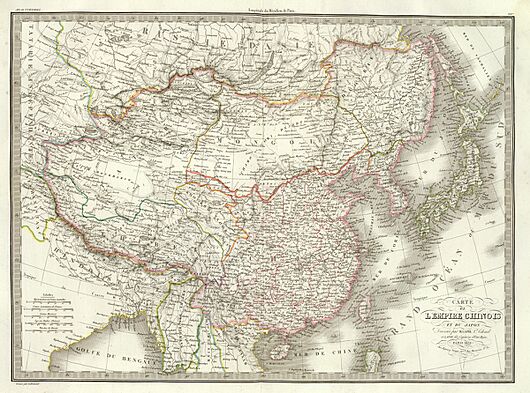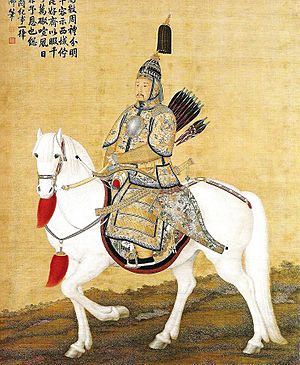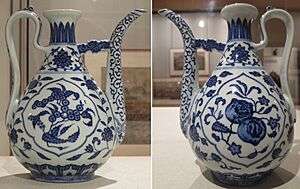High Qing era facts for kids
The High Qing era (also called the High Qing) was a very special time in China's history. It was like a "golden age" for the Qing dynasty. This period lasted from 1683 to 1799. During this time, China was led by three powerful emperors: Kangxi, Yongzheng, and Qianlong. Under their rule, China became very rich and strong.
After the Ming dynasty ended, the High Qing era brought many changes. China became a busy trading country. Its population almost doubled because the country was peaceful and stable. More people also learned to read and write. The empire also grew much larger, especially towards the north and west. During this time, European countries became very interested in Chinese art and style. This trend was called chinoiserie. It became popular because trade with China increased a lot.
Contents
What Made the High Qing Era Special?
The three emperors of the High Qing era were very smart rulers. They mixed their own Manchu culture with some Chinese ways. This helped them keep their identity while also connecting with the people they ruled.
The Kangxi Emperor's Rule
The Kangxi Emperor started the High Qing era. He was a great leader who loved learning and was also a skilled military commander. He made the government better and more open to different cultures. Under Kangxi, China created huge collections of books. These included encyclopedias and dictionaries. Famous examples are the Kangxi Dictionary and the Complete Tang Poems.
The Yongzheng Emperor's Rule
Kangxi's son, the Yongzheng Emperor, ruled for a shorter time. He was known for being strict but also very effective. He worked hard to keep the empire strong and well-managed.
The Qianlong Emperor's Rule
The last emperor of the High Qing was the Qianlong Emperor. He followed his father and grandfather's example. Qianlong was a well-rounded ruler who led the Qing empire to its peak. During his reign, the empire reached its largest size ever. More classic books were written, like Dream of the Red Chamber. The unique ways these emperors ruled helped the High Qing era become so successful. They valued different cultures, which led to a very productive time.
How China's Population Grew
China's economy and living standards greatly improved during the 1700s. This was thanks to more food being grown and more trade happening. The population of China tripled during this century. This growth was much faster than during the Ming period. It happened because of long periods of peace and economic success.
Around 1700, China had about 150 million people. By 1800, this number reached 300 million or more. By the mid-1800s, it was around 450 million. China became the most populated country in the world. Historians agree that China had two big population booms before modern times. One was during the Northern Song period (960–1127). The other was during the Qing period (around 1700–1830). The Qing period's growth was even stronger and lasted longer. It changed China's population history forever.
How the Empire Expanded Its Territory
Besides growing in population, the Qing empire also became much larger. It was bigger than the previous Ming dynasty. The Qing greatly expanded its control into Inner Asia during the High Qing era. This happened especially during the Dzungar–Qing Wars from 1687 to 1758.
The Qing government set up an agency called the Lifan Yuan. This group managed the empire's border regions. The Qing also took control of western areas like Mongolia, Tibet, and Muslim lands. This expansion brought more wealth. The emperors' clever rule and military campaigns, like the Ten Great Campaigns, led to this success. In places like Taiwan, the Qing allowed local leaders to rule. This meant conquered people could keep their culture. The Qing Empire still had final control, but this approach meant fewer rebellions.
How Trade and Business Grew
The High Qing Empire also saw a big return of interest in the arts. Things like porcelain were made in large amounts and used for trade. Literature was also very important. Imperial libraries were built, and more men and women from wealthy families learned to read and write. This focus on education and art helped the economy grow for over fifty years.
Some historians call this period a "second commercial revolution." They say it was even more important than the first one during the Song dynasty. By the end of the 1700s, a "commodity economy" developed. This meant that trade and business reached even small villages in the countryside.
Why More People Learned to Read
Another important change in the High Qing era was that more people learned to read. This included not just men, but women too. As men left home more often for trade, it was believed that women needed to be strong and moral leaders at home. This meant that ideal mothers from wealthy families would also be educated. They learned to read and write so they could teach their sons from a young age. This helped prepare their sons for the civil service examinations in the future. This focus on women's education was a big change from earlier times. It made the High Qing era stand out from other periods in history.
See also
- Chinese expansionism
- Economy of the Qing dynasty
- Golden ages of China
- Pax Sinica
- Chinese Empire
- Tributary system of China
- Legacy of the Qing dynasty




